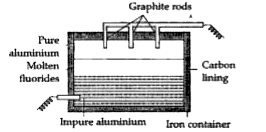In the extraction of chlorine by electrolysis of brine
oxidation of Cl−ion to chlorine gas occurs.
reduction of Cl− ion to chlorine gas occurs.
for overall reaction ΔG has negative value.
a displacement reaction takes place.
The correct Answer is:A
Step-by-Step Solution for the Extraction of Chlorine by Electrolysis of Brine
1. Understanding Brine:
- Brine is a concentrated solution of sodium chloride (NaCl) in water. In the context of electrolysis, we often refer to the brine solution rather than molten NaCl.
2. Electrolysis Setup:
- In the electrolysis of brine, an electrochemical cell is set up with two electrodes: an anode (positive electrode) and a cathode (negative electrode).
3. Dissociation of NaCl:
- When brine (NaCl solution) is subjected to electrolysis, it dissociates into its ions: sodium ions (Na⁺) and chloride ions (Cl⁻).
4. Oxidation at the Anode:
- At the anode, oxidation occurs. The chloride ions (Cl⁻) migrate towards the anode where they lose electrons (are oxidized) to form chlorine gas (Cl₂).
- The half-reaction at the anode can be represented as:
2Cl⁻→Cl₂(g)+2e⁻
5. Reduction at the Cathode:
- At the cathode, reduction occurs. The sodium ions (Na⁺) migrate towards the cathode where they gain electrons (are reduced) to form sodium metal (Na).
- The half-reaction at the cathode can be represented as:
Na⁺+e⁻→Na(s)
6. Overall Reaction:
- The overall reaction for the electrolysis of brine can be summarized as:
2NaCl(aq)+2H₂O(l)→Cl₂(g)+H₂(g)+2NaOH(aq)
- This shows that chlorine gas is produced at the anode, hydrogen gas at the cathode, and sodium hydroxide remains in the solution.
7. Conclusion:
- Therefore, the extraction of chlorine gas occurs through the oxidation of chloride ions at the anode during the electrolysis of brine.
- Brine is a concentrated solution of sodium chloride (NaCl) in water. In the context of electrolysis, we often refer to the brine solution rather than molten NaCl.
- In the electrolysis of brine, an electrochemical cell is set up with two electrodes: an anode (positive electrode) and a cathode (negative electrode).
- When brine (NaCl solution) is subjected to electrolysis, it dissociates into its ions: sodium ions (Na⁺) and chloride ions (Cl⁻).
- At the anode, oxidation occurs. The chloride ions (Cl⁻) migrate towards the anode where they lose electrons (are oxidized) to form chlorine gas (Cl₂).
- The half-reaction at the anode can be represented as:
2Cl⁻→Cl₂(g)+2e⁻
- At the cathode, reduction occurs. The sodium ions (Na⁺) migrate towards the cathode where they gain electrons (are reduced) to form sodium metal (Na).
- The half-reaction at the cathode can be represented as:
Na⁺+e⁻→Na(s)
- The overall reaction for the electrolysis of brine can be summarized as:
2NaCl(aq)+2H₂O(l)→Cl₂(g)+H₂(g)+2NaOH(aq)
- This shows that chlorine gas is produced at the anode, hydrogen gas at the cathode, and sodium hydroxide remains in the solution.
- Therefore, the extraction of chlorine gas occurs through the oxidation of chloride ions at the anode during the electrolysis of brine.
Topper's Solved these Questions
- BOOK - ICSECHAPTER - GENERAL PRINCIPLES AND PROCESSES OF ISOLATION OF ELEMENTS EXERCISE - EXERCISE (PART-I ( OBJECTIVE QUESTIONS ))24videos
GENERAL PRINCIPLES AND PROCESSES OF ISOLATION OF ELEMENTS
- BOOK - ICSECHAPTER - GENERAL PRINCIPLES AND PROCESSES OF ISOLATION OF ELEMENTS EXERCISE - EXERCISE (PART-I ( OBJECTIVE QUESTIONS )) (MATCH THE FOLLOWING)6videos
GENERAL PRINCIPLES AND PROCESSES OF ISOLATION OF ELEMENTS
- BOOK - ICSECHAPTER - ELECTROCHEMISTRYEXERCISE - ISC EXAMINATION QUESTIONS (PART-II Numerical Problems)19videos
ELECTROCHEMISTRY
- BOOK - ICSECHAPTER - HALOALKANES AND HALOARENES EXERCISE - SOURCE9videos
HALOALKANES AND HALOARENES
Similar Questions
The following questions relate to the extraction of aluminium by electrolysis :
Give the equation for the reaction that takes place at the cathode.View SolutionThe following questions related to the extraction of aluminium by electrolysis :
Give the equation for the reaction that takes place at cathode.View SolutionThe following questions related to the extraction of aluminium by electrolysis :
What is the role of graphite?View SolutionThe following question relate to the extraction of aluminium by electrolysis.
Give equation for the reaction that takes place at the cathode.View SolutionThe following questions related to the extraction of aluminium by electrolysis :
Explain why it is necessary to renew anode from time to time?View SolutionThe following questions relate to the extraction of aluminium by electrolysis :
Explain why is it necessary to renew the anode periodically.View SolutionThe following questions relate to the extraction of aluminium by electrolysis :
Name the other aluminium containing compound added to alumina and state its significance.View SolutionThe following question relate to the extraction of aluminium by electrolysis:

Explain why is it necessary to renew the anode periodically.View SolutionThe following question relate to the extraction of aluminium by electrolysis:

Give the equation for the reaction that takes place at the cathode.View SolutionDuring electrolysis :
View Solution

